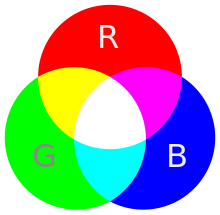
Back RGB-kleurmodel Afrikaans النموذج اللوني أحمر أخضر أزرق Arabic RGB Azerbaijani RGB Byelorussian RGB цветови модел Bulgarian আরজিবি রং মডেল Bengali/Bangla RGB BS Model de color RGB Catalan RGB Czech RGB-farver Danish


The RGB color model is an additive color model[1] in which the red, green, and blue primary colors of light are added together in various ways to reproduce a broad array of colors. The name of the model comes from the initials of the three additive primary colors, red, green, and blue.[2]
The main purpose of the RGB color model is for the sensing, representation, and display of images in electronic systems, such as televisions and computers, though it has also been used in conventional photography and colored lighting. Before the electronic age, the RGB color model already had a solid theory behind it, based in human perception of colors.
RGB is a device-dependent color model: different devices detect or reproduce a given RGB value differently, since the color elements (such as phosphors or dyes) and their response to the individual red, green, and blue levels vary from manufacturer to manufacturer, or even in the same device over time. Thus an RGB value does not define the same color across devices without some kind of color management.[3][4]
Typical RGB input devices are color TV and video cameras, image scanners, and digital cameras. Typical RGB output devices are TV sets of various technologies (CRT, LCD, plasma, OLED, quantum dots, etc.), computer and mobile phone displays, video projectors, multicolor LED displays and large screens such as the Jumbotron. Color printers, on the other hand, are not RGB devices, but subtractive color devices typically using the CMYK color model.
- ^ Cite error: The named reference
:0was invoked but never defined (see the help page). - ^ Fairman, Hugh S.; Brill, Michael H.; Hemmendinger, Henry (February 1997). "How the CIE 1931 color-matching functions were derived from Wright-Guild data". Color Research & Application. 22 (1): 11–23. doi:10.1002/(SICI)1520-6378(199702)22:1<11::AID-COL4>3.0.CO;2-7.
The first of the resolutions offered to the 1931 meeting defined the color-matching functions of the soon-to-be-adopted standard observer in terms of Guild's spectral primaries centered on wavelengths 435.8, 546.1, and 700nm. Guild approached the problem from the viewpoint of a standardization engineer. In his mind, the adopted primaries had to be producible with national-standardizing-laboratory accuracy. The first two wavelengths were mercury excitation lines, and the last named wavelength occurred at a location in the human vision system where the hue of spectral lights was unchanging with wavelength. Slight inaccuracy in production of the wavelength of this spectral primary in a visual colorimeter, it was reasoned, would introduce no error at all.
- ^ GrantMeStrength (30 December 2021). "Device-Dependent Color Spaces - Win32 apps". learn.microsoft.com. Retrieved 2022-10-24.
- ^ Crean, Buckley. "Device Independent Color—Who Wants It?" (PDF). SPIE. 2171: 267.